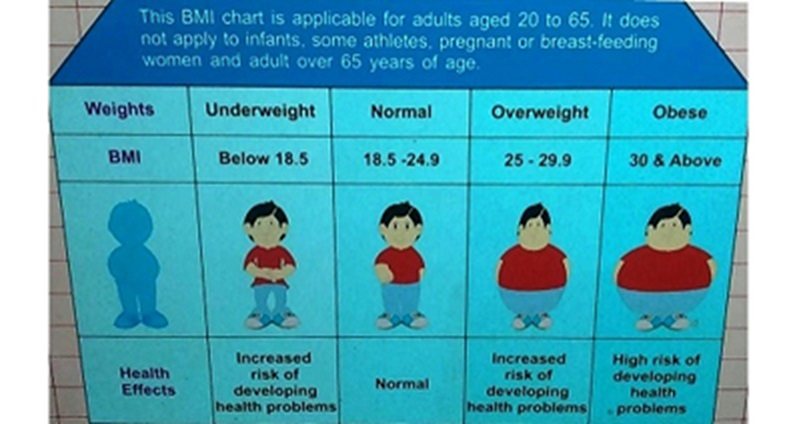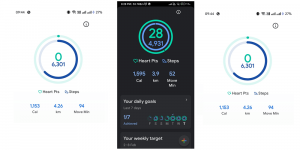
Body Mass Index (BMI) is a ratio of your weight and height, and depending on the value one can be categorised as underweight, ideal, overweight or obese. Usually, BMI from 18.5 up to 25 is considered to be healthy.
Using a BMI Chart and calculator, one can easily determine the BMI.
BMI (along with other health indicators) is widely use by doctors, fitness instructors and nutritionists to assess the current health status and related health risks of a person.
Not sure if you are on the thinner side or slightly on the fatty side?
Determine your BMI with the calculator below.
What Is BMI?
BMI stands for Body Mass Index. It is basically a chart that helps you determine your body weight relative to your height.
A Body mass index chart tells you if you have the right amount of fat, or are you over-weight (or underweight).
The BMI chart is applicable for adults aged 20 to 65. It does not apply to infants, pregnant or brast-feeding women and adult over 65 years of age.
The Body Mass Index (BMI) formula was developed by Belgium statistician Adolphe Quetelet, and is also known as the Quetelet Index.
The BMI chart and the BMI calculator below provide a numeric measure of your “thinness” or “fatness”. Use it to determine your Body Mass Index.
- BMI between 20 and 22: Ideal, healthy amount of body fat, makes you look attractive.
- BMI between 22 and 25: Acceptable range, considered to be healthy.
- BMI between 25 and 30: On the “Hefty” side, time to lower your weight, through diet and exercise.
- BMI over 30: Unhealthy condition, likely to have heart disease, diabetes, high blood pressure, and more. time to get serious about losing weight.
- It does not tell you where fat is located
- Does not distinguish between fat mass and muscle mass
- Body Fat Calipers – Measure fat by making a fold in the skin
- Body Fat Scales – Easiest to use, you don’t need any expert help
- More on Body Fat Calculator
As you can see, besides BMI, the chart shows various other parameters like BMR (Basal Metabolic Rate), WHR (Wait to Hip Ratio), PBF (Percentage Body Fat), Proteins, TBW (total Body Water), SMM (Skeletal Muscle Mass). You have to provide yourage, weight, and height.
BMI Chart – How Do You Read It?
Depending on what your BMI is…your body composition could be placed in one of the following categories.
Under weight 18.5
Healthy 19-25
Overweight 25-30
Obese 30+
Obviously, a high BMI increases your risk of diseases and aliments.
Diabetes, hypertension, heart diseases, certain types of cancers are just a few of the problems that have been linked to people with very high BMI.
So watch out for your BMI – Body Mass Index!
BMI Calculators
Limitations of a BMI Chart
There a couple of limitations though with using a BMI chart!
The obvious problem with the second point is that if you have a lot of muscle mass, your BMI could be calculated in the over-weight range.
But in this case you have more of muscles…so nothing to worry about!
If your BMI is high and you do not have a pot belly, then you are probably alright.
Who Should Use BMI Charts?
BMI charts are usually used by obese individuals, where it is difficult to determine your body composition with calipers.
A better measure of your body composition is by measuring Body Fat!
You can have this checked by a professional, or if you have a pair of calipers you can do it yourself here.
Athlete < 10%
Lean 10-15%
Normal 15-18%
Above Average 18-20%
Over-weight 20-25%
Obese 25+%
Athlete < 17%
Lean 17-22%
Normal 22-25%
Above Average 25-29%
Over-weight 29-35%
Obese 35+%
BMI for Seniors / Over 65
The Body Mass Index (BMI) used for older people (above 65) is different than the general population’s normal ranges, says a report.
Doctors recommend that instead of focusing on weight loss, older people should have more of a balanced diet, eat when hungry and keep active.
“It is time to reassess the healthy weight guidelines for older people. Our results showed that those over the age of 65 with a BMI of between 23 and 33 lived longer, indicating that the ideal body weight for older people is significantly higher than the recommended 18.5-25 ‘normal’ healthy weight range,” Caryl Nowson, a professor of nutrition and aging at Deakin University.
Summary
If you think you are either on the thinner side or slightly on the fatter side, measuring your BMI is the first step before you start working upon it. The BMI calculator provided here will help you easily calculate your Body Mass Index, an indicator of whether you are under-weight, healthy, overweight, or obese.
Read here for a better way to calculate Body Fat!









Leave a Reply